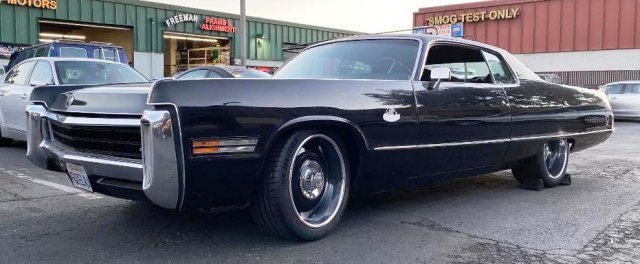- Member ID
- #26086
- Messages
- 2
- Reactions
- 2
- Likes
- 1
- City
- San Lorenzo
- State
- CA
- Country
- United States
- Vehicle
- 1972 Chrysler Imperial GT w 2018 Durango parts
I have a 1972 Imperial. I drive it fast on road rallies and eat people in little vintage EuroTrash cars when I do.
Had a problem where I burned 3 of the 4 brakes off the car while intimidating an Austin Healy just west of Lake Tahoe.
So I redid the car's stoppers and am stumped:
Inventory
2018 Durango SRT Master Cylinder, Booster, Calipers, and Rotors.
My plumbing, Stainless lines to f wheels and rear axle.
ABS module and anything else that was on the Durango otherwise is deleted
I have bled by vacuum, pulling fluid out of the calipers.
I have bled by pressure, forcing fluid up from the calipers.
I have cracked the fittings at the MC while the pedal was depressed.
I have used pressure with the MC off the booster, tilted at an angle so that the lines are inclined to promote bubbles going UP and not flat where they might hide in a pocket.
Removing the MC from booster while car off, even long time, there is a hiss as the seal between MC and booster breaks - vacuum remains until MC is pulled, so booster ?not? leaking down.
Only variance from stock application is that the Durango has a tilted plane on the firewall, with the MC inclined.
My firewall is vertical flat. I modded the reservoir to be flat and it is not part of the problem/no leaks, etc.
I have put at least a gallon of brake fluid out of spite and stubbornness, but still get the same outcome.
I don't think that it is an air bubble, but have no other explanation that I can imagine.
Bench Bled, that didn't seem to help - the number of fittings at the MC makes timely, effcient reassembly a challenge.
What do you think?

Kenyon
Had a problem where I burned 3 of the 4 brakes off the car while intimidating an Austin Healy just west of Lake Tahoe.
So I redid the car's stoppers and am stumped:
Inventory
2018 Durango SRT Master Cylinder, Booster, Calipers, and Rotors.
My plumbing, Stainless lines to f wheels and rear axle.
ABS module and anything else that was on the Durango otherwise is deleted
- Pedal is firm and GREAT when the car is off.
- Pedal is soft and slowly sinks when car is on.
I have bled by vacuum, pulling fluid out of the calipers.
I have bled by pressure, forcing fluid up from the calipers.
I have cracked the fittings at the MC while the pedal was depressed.
I have used pressure with the MC off the booster, tilted at an angle so that the lines are inclined to promote bubbles going UP and not flat where they might hide in a pocket.
Removing the MC from booster while car off, even long time, there is a hiss as the seal between MC and booster breaks - vacuum remains until MC is pulled, so booster ?not? leaking down.
- -Is the MC side of the booster supposed to have zero vacuum when MC is pulled?
- I have had same results with two different used boosters. Perhaps both were bad? -I doubt it strongly.
Only variance from stock application is that the Durango has a tilted plane on the firewall, with the MC inclined.
My firewall is vertical flat. I modded the reservoir to be flat and it is not part of the problem/no leaks, etc.
I have put at least a gallon of brake fluid out of spite and stubbornness, but still get the same outcome.
I don't think that it is an air bubble, but have no other explanation that I can imagine.
Bench Bled, that didn't seem to help - the number of fittings at the MC makes timely, effcient reassembly a challenge.
What do you think?

Kenyon
Last edited by a moderator:
-
1
- Show All
